#E L Blanchard
Text
Anna Cora Mowatt and Anne Blake
Part I: Intriguing, But Less Than Ground-Breaking
[A recording of this play is available at Librivox]
John Westland Marston’s 1852 play, “Anne Blake” makes me glad I’m writing a blog. As you may have noticed, researching Anna Cora Mowatt’s acting roles has caused me to develop a taste for mid-19th-century popular drama. I found this script to be a wonderful example of the genre. If you too find…
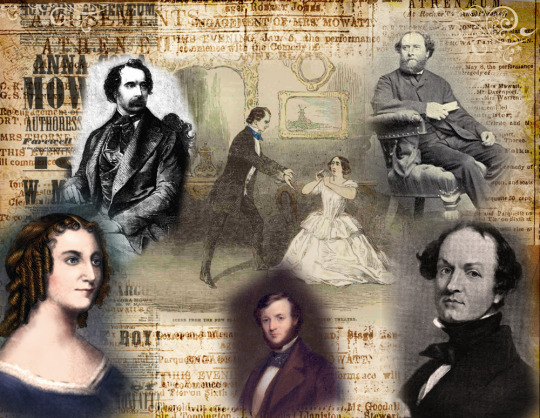
View On WordPress
#anna cora mowatt#Anne Blake#charles dickens#E. L. Blanchard#Edward Bulwer-Lytton#John Westland Marston#Robert Browning#The Lady Actress#theater history#theatre history#Victorian Actress#Victorian Literature#Victorian theater#victorian theatre#William Macready
6 notes
·
View notes
Text
Interesting Papers for Week 26, 2023
Saturation of visual responses explains size tuning in rat collicular neurons. Baranauskas, G., Rysevaite‐Kyguoliene, K., Sabeckis, I., & Pauza, D. H. (2023). European Journal of Neuroscience, 57(2), 285–309.
Reconstruction of sparse recurrent connectivity and inputs from the nonlinear dynamics of neuronal networks. Barranca, V. J. (2023). Journal of Computational Neuroscience, 51(1), 43–58.
Population codes enable learning from few examples by shaping inductive bias. Bordelon, B., & Pehlevan, C. (2022). eLife, 11, e78606.
Cerebro-cerebellar networks facilitate learning through feedback decoupling. Boven, E., Pemberton, J., Chadderton, P., Apps, R., & Costa, R. P. (2023). Nature Communications, 14, 51.
The role of the lateral orbitofrontal cortex in creating cognitive maps. Costa, K. M., Scholz, R., Lloyd, K., Moreno-Castilla, P., Gardner, M. P. H., Dayan, P., & Schoenbaum, G. (2023). Nature Neuroscience, 26, 107–115.
Functional geometry of the cortex encodes dimensions of consciousness. Huang, Z., Mashour, G. A., & Hudetz, A. G. (2023). Nature Communications, 14, 72.
Optimal Control Costs of Brain State Transitions in Linear Stochastic Systems. Kamiya, S., Kawakita, G., Sasai, S., Kitazono, J., & Oizumi, M. (2023). Journal of Neuroscience, 43(2), 270–281.
Do cognitive and physical effort costs affect choice behavior similarly? Lim, L. X., Fansher, M., & Hélie, S. (2023). Journal of Mathematical Psychology, 112, 102727.
Deciphering functional roles of synaptic plasticity and intrinsic neural firing in developing mouse visual cortex layer IV microcircuit. Liu, S., & Li, Y. (2023). Journal of Computational Neuroscience, 51(1), 23–42.
Arithmetic value representation for hierarchical behavior composition. Makino, H. (2023). Nature Neuroscience, 26, 140–149.
Altered integration of excitatory inputs onto the basal dendrites of layer 5 pyramidal neurons in a mouse model of Fragile X syndrome. Mitchell, D. E., Miranda-Rottmann, S., Blanchard, M., & Araya, R. (2023). Proceedings of the National Academy of Sciences, 120(2), e2208963120.
Introducing the Dendrify framework for incorporating dendrites to spiking neural networks. Pagkalos, M., Chavlis, S., & Poirazi, P. (2023). Nature Communications, 14, 131.
A statistical foundation for derived attention. Paskewitz, S., & Jones, M. (2023). Journal of Mathematical Psychology, 112, 102728.
Rapid synaptic and gamma rhythm signature of mouse critical period plasticity. Quast, K. B., Reh, R. K., Caiati, M. D., Kopell, N., McCarthy, M. M., & Hensch, T. K. (2023). Proceedings of the National Academy of Sciences, 120(2), e2123182120.
Lingering Neural Representations of Past Task Features Adversely Affect Future Behavior. Rangel, B. O., Hazeltine, E., & Wessel, J. R. (2023). Journal of Neuroscience, 43(2), 282–292.
Evidence for entropy maximisation in human free choice behaviour. Rens, N., Lancia, G. L., Eluchans, M., Schwartenbeck, P., Cunnington, R., & Pezzulo, G. (2023). Cognition, 232, 105328.
Choice selective inhibition drives stability and competition in decision circuits. Roach, J. P., Churchland, A. K., & Engel, T. A. (2023). Nature Communications, 14, 147.
Information-processing dynamics in neural networks of macaque cerebral cortex reflect cognitive state and behavior. Varley, T. F., Sporns, O., Schaffelhofer, S., Scherberger, H., & Dann, B. (2023). Proceedings of the National Academy of Sciences, 120(2), e2207677120.
Transformation of acoustic information to sensory decision variables in the parietal cortex. Yao, J. D., Zemlianova, K. O., Hocker, D. L., Savin, C., Constantinople, C. M., Chung, S., & Sanes, D. H. (2023). Proceedings of the National Academy of Sciences, 120(2), e2212120120.
Hippocampal spatial representations exhibit a hyperbolic geometry that expands with experience. Zhang, H., Rich, P. D., Lee, A. K., & Sharpee, T. O. (2023). Nature Neuroscience, 26, 131–139.
#science#Neuroscience#computational neuroscience#Brain science#research#cognition#cognitive science#neurons#neurobiology#neural networks#neural computation#psychophysics#scientific publications
23 notes
·
View notes
Text
Project 21 Season 8 Combo Links
Combined Levels & Masterclasses
September/ MegaMix 2000 (Earth, Wind, Fire)- Molly Long 9/21
All Minis, Juniors, Seniors
Level 1 (Minis)
Cruisin' for a Bruisin' (Teen Beach Movie)- Jazelle Torre 9/28
Chloe Mirabal
Madelyn Nasu
Level 2 (Juniors)
No Excuses (Meghan Trainor)- Molly Long 9/14
Demi U, Leighton W, Lilly B
Diana, Isabella K, Regan G
Cali C, Esme C, Sara VR
Diana Kouznetsova
Rey Rey Gerena
Ellie Anbardan
Ain't No Other Man (Christina Aguilera)- Molly Long 9/18
Many Dancers
Demi U, Dillon B, Leighton W, Lilly B, Stella E
Airi DC, Makeila B, Melina
Chloe M, Jilly M, Savanna M
Diana Kouznetsova
Ellie Anbardan
Esme Chou
Isabella Kouznetsova
Sara Von Rotz
Tatum Brady
Glam (Christina Aguilera)- Jazelle Torre 10/3
Demi U, Dillon B, Leighton W, Lilly B, Stella E
Diana K, Isabella K, Regan G
Airi DC, Makeila B, Tatum B
Cali Cassidy (2)
Demi Ulloa (4)
Diana Kouznetsova
Dillion Barron (5)
Leighton Werner (6)
Sara Von Rotz (3)
Stella Eberts (2)
Angeleyes (ABBA)- Molly Long 10/13
Chloe M, Ellie A, Jilly M
Diana K, Esme C
Tatum B, Winter E
Regan Gerena
Sara Von Rotz
Level 3 (Teens/Seniors)
Gimmie Dat (Ciara)- Molly Long 9/7
All Seniors (6)
Anya I, Gracyn F, Kendyl F, Lexi B, Maddie O, Maya L, Rylee Y
Ava W, Avery R, Mady K
Anya I, Maya L, Rylee Y
Bella P, Kai A, Leighton W
Brielle L, Lilly B, Stella E
Davyd W, Gracyn F, Richie G
Elle O, Jojo J, Zuzu D (2)
Gracyn F, Kendyl F, Lexi B (2)
Kai A, Kenz C, Sienna C
Kami C, Loila R, Sammi C
Ava Woinarowicz
Davyd Williams
Elle O’Donnell
Gracyn French
Jojo Jessen
Kendyl Fay
Lexi Blanchard
Lilly Barajas
Loila Rhee (7)
Maya Loureiro
Rylee Young
Zuzu Duchon
Cuff It (Beyoncé)- Molly Long 9/14
All Seniors (6)
Anya I, Gracyn F, Kendyl F, Maddie O, Maya L (4)
Elle O, Jojo J, Loila R, Sammi C, Zuzu D (2)
Anya I, Maya L, Rylee Y (5)
Kami C, Katie C, Kenz C
Anya Inger
Brielle Lieberman
Dillon Barron
Elle O’Donnell
Gracyn French
Jojo Jessen
Kami C
Lexi Blanchard
Maddie Ortega
Maya Loureiro
Richie Granese
Zuzu Duchon
Pure/Honey (Beyoncé)- Jazelle Torre 9/28
All Dancers
Bella P, Kai A, Kendyl F, Mady K, Maya L, Stella E
Anya I, Maya L, Rylee Y
Gracyn F, Kendyl F, Maddie O
Kenz C, Loila R, Sienna C (7)
Ava Woinarowicz
Elle O’Donnell (6)
Gracyn French
Jojo Jessen
Kenz Couch
Mady Kim
Stella Eberts
Fabulous (C.U.T)- Molly Long
Anya I, Gracyn F, Kendyl F, Lexi B, Maddie O, Maya L, Rylee Y
Brielle L, Brooklyn L, Kai A, Kenz C, Sienna C
Anya I, Maddie O, Maya L
Ava W, Leighton W, Mady K
Elle O’Donnell
Gracyn French
Jojo Jessen
Lexi Blanchard
Maddie Ortega (2)
Selena Hamilton
Jumpin', Jumpin' (Destiny’s Child)- Molly Long
Gracyn F, Jojo J, Kendyl F
Maya Loureiro
Stella Eberts
50 notes
·
View notes
Text
My 2023 Reading List
Here's the books and articles that I read in 2023 (a large part of which was a push to finish my dissertation). I thought it might also be useful to others to see what my workload looks like as a 7th year grad student in a PhD. program, especially since I'm unmedicated with severe ADHD. This is what I'm able to get done while fighting through that. I bring this up because I know that it can seem fucking impossible, most notably when we see our neurotypical colleagues churning through incredible amounts of research. A final note: two of the books I'm including in here are books that I started reading in 2022 (Kagan and Stock). Also, note that many of these are re-reads; I've marked these with an Asterisk, and a couple of the books I read around 90%, but dropped a couple chapters that weren't relevant for my projects. These are marked with two asterisks. Be aware that my citations here are of a pretty rough and ready style. Philosophy has weird disciplinary standards (read, almost every journal is different), so I just have a "here's what you need to know to find it" style here.
CW: I work on some dark things involving death, suicide, sexual assault, sex, race, and trans rights, including actively fighting trans-exclusive theorists, so there's a lot of possibly triggering things in here.
Updated: Jan 4, 2024
Abdollah, Serajian, Ebrahim Khosrow, and Sajad Ahmadizad. 2014. “Comparison of Anthropometric and Functional Characteristics of Elite Male Iranian Fencers in Three Weapons.” International Journal of Applied Sport Sciences 26 (1): 11–17.
Alcoff, Linda. 1991. “The Problem of Speaking for Others.” Cultural Critique No. 20 5–32.
Alcoff, Linda. 2007. “Epistemologies of Ignorance: Three Types.” In Race and Epistemologies of Ignorance, edited by Shannon and Tuana Sullivan, Nancy, 39–50. Albany: State University of New York Press.
Anderson, Elizabeth. 2012. “Epistemic Justice as a Virtue of Social Institutions.” Social Epistemology 26 (2): 163–73.
Andler, Matthew. 2017. “Gender Identity and Exclusion: A Reply to Jenkins.” Ethics
Ashley, Florence. 2023. “What is it Like to Have a Gender Identity.” Mind 132 (528): 1053–73.
Ballantyne, Nathan. 2019. “Epistemic Trespassing.” Mind 128 (510): 367–95.
Ballantyne, Nathan, Jared Celniker, and David Dunning. 2022. “Do Your Own Research.” Social Epistemology
Barnett, Brian S, Ariana E Nesbit, and Reneé M Sorrentino. 2018. “The Transgender Bathroom Debate At the Intersection of Politics, Law, Ethics, and Science.” J Am Acad Psychiatry Law 46 (2): 232–41.*
Berg, Amy. 2022. “Is There a Duty to Read the News.” Journal of Moral Philosophy 20 (3-4): 243–67.
Bergero-Miguel, Trinidad, María A García-Encinas, Amelia Villena-Jimena, Lucía Pérez-Costillas, Nicolás Sánchez-Álvarez, Yolanda de Diego-Otero, and Jose Guzman-Parra. 2016. “Gender Dysphoria and Social Anxiety: An Exploratory Study in Spain.” J Sex Med 13 (8): 1270–78.*
Bettcher, Talia Mae. 2009. “Trans Identities and First-Person Authority.” In You’Ve Changed: Sex Reassignment and Personal Identity, edited by Laurie Shrage, 98–120. Oxford University Press.*
Biggs, Michael. Suicide By Trans-Identified Children in England and Wales. Transgender Trend.*
Blair, Karen L., and Rhea Ashley Hoskin. 2019. “Transgender Exclusion From the World of Dating: Patterns of Acceptance and Rejection of Hypothetical Trans Dating Partners as a Function of Sexual and Gender Identity.” Journal of Social and Personal Relationships 36 (7): 2074–95.
Blanchard, Matt, and Barry Farber. 2016. “Lying in Psychotherapy: Why and What Clients Don’t Tell Their Therapist About Therapy and Their Relationship.” Counselling Psychology Quarterly 29 (1): 90–112.
Blanchard, Matt, and Barry Farber. 2020. “”It is Never Okay to Talk About Suicide”: Patients’ Reasons for Concealing Suicidal Ideation in Psychotherapy.” Psychother Res 30 (1): 124–36.
Bochicchio, Lauren, Kelsey Reeder, Lauren Aronson, Charles McTavish, and Ana Stefancic. 2021. “Understanding Factors Associated With Suicidality Among Transgender and Gender-Diverse Identified Youth.” LGBT Health 8 (4): 245–53.
Bradley, Ben. 2012. “Doing Away With Harm.” Philosophy and Phenomenological Research 85, No. 2 390–412.*
Brown, Brookes. 2023. “Bearing Witness: The Duty of Non‐indifference and the Case for Reading the News.” Pacific Philosophical Quarterly 104 (2): 368–91.
Bustos, Valeria P, Samyd S Bustos, Andres Mascaro, Gabriel Del Corral, Antonio J Forte, Pedro Ciudad, Esther A Kim, Howard N Langstein, and Oscar J Manrique. 2021. “Regret After Gender-Affirmation Surgery: A Systematic Review and Meta-Analysis of Prevalence.” Plast Reconstr Surg Glob Open 9 (3): e3477.*
Byrne, Alex. 2020. “Are Women Adult Human Females.” Philosophical Studies 177 (12): 3783–803.
Carel, Havi, and Ian Kidd. 2014. “Epistemic Injustice in Healthcare: A Philosophical Analysis.” Med Health Care Philos 17 (4): 529–40.
Cattien, Jana. 2019. “Against “Transracialism”: Revisiting the Debate.” Hypatia 34 (4): 713–35.
Clements-Nolle, Kristen, Rani Marx, and Mitchell Katz. 2006. “Attempted Suicide Among Transgender Persons: The Influence of Gender-Based Discrimination and Victimization.” Journal of Homosexuality 51 (3): 53–69.*
Congdon, Matthew. 2018. ““Knower” as an Ethical Concept: From Epistemic Agency to Mutual Recognition.” Feminist Philosophy Quarterly 4 (4):
Costa, Rosalia, and Marco Colizzi. 2016. “The Effect of Cross-Sex Hormonal Treatment on Gender Dysphoria Individuals’ Mental Health: A Systematic Review.” Neuropsychiatr Dis Treat 12 1953–66.*
Crichton, Carel, & Kidd. 2017. Epistemic Injustice in Psychiatry. BJPsych Bulletin. 41:65-70.
Crocker, David. 1991. “Insiders and Outsiders in International Development.” Ethics and International Affairs 5 149–73.
Cullison, Andrew. 2010. “On the Nature of Testimony.” Episteme
Daniels, Norman. 2015. “Why We Should Care About the Social Determinants of Health.” Am J Bioeth 15 (3): 37–38.
Davey, Amanda, Walter Pierre Bouman, Caroline Meyer, and Jon Arcelus. 2015. “Interpersonal Functioning Among Treatment-Seeking Trans Individuals.” J Clin Psychol 71 (12): 1173–85.*
Davey, Amanda, Walter Pierre Bouman, Jon Arcelus, and Caroline Meyer. 2014. “Social Support and Psychological Well-Being in Gender Dysphoria: A Comparison of Patients With Matched Controls.” J Sex Med 11 (12): 2976–85.*
Davis, Emmalon. 2016. “Typecasts, Tokens, and Spokespersons: A Case for Credibility Excess as Testimonial Injustice.” Hypatia 31 (3): 485–501.
Dees, Richard H. 2019. “Primum Non Nocere Mortuis: Bioethics and the Lives of the Dead.” Journal of Medicine and Philosophy 44 (6): 732–55.
Dembroff, Robin. 2020. “Beyond Binary: Genderqueer as Critical Gender Kind.” Philosophers’ Imprint 20 (9): 1–23.*
Dembroff, Robin, and Dennis Whitcomb. Forthcoming. “Content-Focused Epistemic Injustice.” Oxford Studies in Epistemology*
DiPaolo, Joshua. 2022. “What’s Wrong With Epistemic Trespassing.” Philosophical Studies 179 (1): 223–43.
DiPaolo, Joshua. Forthcoming. “”I’m, Like, a Very Smart Person” on Self-Licensing and Perils of Reflection.” Oxford Studies in Epistemology
Dormandy, Katherine. 2018. “Epistemic Authority: Preemption or Proper Basing.” Erkenntnis 83 (4): 773–91.
Dotson, Kristie. 2008. “In Search of Tanzania: Are Effective Epistemic Practices Sufficient for Just Epistemic Practices?” Southern Journal of Philosophy 46 (S1): 52–64.*
Dotson, Kristie. 2011. “Tracking Epistemic Violence, Tracking Practices of Silencing.” Hypatia 26 (2): 236–57.*
Dotson, Kristie. 2012. “A Cautionary Tale: On Limiting Epistemic Oppression.” Frontiers: A Journal of Women Studies 33 (1): 24–47.*
Dotson, Kristie. 2014. “Conceptualizing Epistemic Oppression.” Social Epistemology 28 (2): 115–38.*
Frost-Arnold, Karen. 2014a. “Imposters, Tricksters, and Trustworthiness as an Epistemic Virtue.” Hypatia 29 (4): 790–807.
Frost-Arnold, Karen. 2014b. “The Cognitive Attitude of Rational Trust.” Synthese 191 (9): 1957–74.
Frost-Arnold, Karen. 2014c. “Trustworthiness and Truth: The Epistemic Pitfalls of Internet Accountability.” Episteme 11 (1): 63–81.
Funkhouser, Eric. 2017. “Beliefs as Signals: A New Function for Belief.” Philosophical Psychology 30 (6): 809–31.
Gardner, Molly. 2015. “A Harm-Based Solution to the Non-Identity Problem.” Ergo 2 427–44.*
Gardner, Molly. 2019. “When Good Things Happen to Harmed People.” Ethical Theory and Moral Practice 22 (4): 893–908.
Gijs, Luk, and Anne Brewaeys. 2007. “Surgical Treatment of Gender Dysphoria in Adults and Adolescents: Recent Developments, Effectiveness, and Challenges.” Annual Review of Sex Research 18 (1): 178–224.*
Goldman, Alvin I. 2001. “Experts: Which Ones Should You Trust.” Philosophy and Phenomenological Research 63 (1): 85–110.
Harcourt, Edward. 2021. “Epistemic Injustice, Children and Mental Illness.” J Med Ethics 47 (11): 729–35.
Hardwig, John. 1985. “Epistemic Dependence.” The Journal of Philosophy 82 (7): 335–49.
Harvin, Cassandra Byers. 1996. “Conversations I Can’t Have.” One the Issues: The Progressive Women’s Quartery 5 (2): 15–16.
Hookway, Christopher. 2010. “Some Varieties of Epistemic Injustice: Reflections on Fricker.” Episteme 7 (2): 151–63.
Intemann, Kristen. 2010. “25 Years of Feminist Empiricism and Standpoint Theory: Where Are We Now.” Hypatia 25 (4): 778–96.
Jaggar, Alison M. 1998. “Globalizing Feminist Ethics.” Hypatia 13 (2): 7–31.
Jenkins, Katharine. 2016. “Amelioration and Inclusion: Gender Identity and the Concept of Woman.” Ethics 126 (2): 394–421.*
Jenkins, Katharine. 2018. “Toward an Account of Gender Identity.” Ergo, an Open Access Journal of Philosophy 5 (20201214):
Jenness, Valerie, Cheryl L. Maxson, Kristy N Matsuda, and Jennifer Macy Sumner. 2007. “Violence in California Correctional Facilities: An Empirical Examination of Sexual Assault.” The Bulletin 2 (2): 1–4.
Joshi, Hrishikesh. 2022a. “Debunking Creedal Beliefs.” Synthese 200 (6):
Joshi, Hrishikesh. 2022b. “The Epistemic Significance of Social Pressure.” Canadian Journal of Philosophy 52 (4): 396–410.
Kaltial-Heino, Rittakerttu, Maria Sumia, Marja Työläjärvi, and Nina Lindberg. 2015. “Two Years of Gender Identity Service for Minors: Overrepresentation of Natal Girls With Severe Problems in Adolescent Development.” Child and Adolescent Psychiatry and Mental Health 9 (9): *
Kidd, Ian James, Lucienne Spencer, and Havi Carel. 2023. “Epistemic Injustice in Psychiatric Research and Practice.” Philosophical Psychology 1–29.
Kukla, Rebecca. 2007. “Objectivity and Perspective in Empirical Knowledge.” Episteme 3 (1-2): 80–95.
Kurs, Rena, and Alexander Grinshpoon. 2018. “Vulnerability of Individuals With Mental Disorders to Epistemic Injustice in Both Clinical and Social Domains.” Ethics & Behavior 28 (4): 336–46.
Larbalestier, Jan. 1990. “The Politics of Representation: Australian Aboriginal Women and Feminism.” Anthropological Forum 6 (2): 143–57.
Lee, J. Y. 2021. “Anticipatory Epistemic Injustice.” Social Epistemology 35 (6): 564–76.
Levy, Andrea, Aaron Scherer, Brian Zikmund-Fisher, Knoll Larkin, Geoffrey Barnes, and Angela Fagerlin. 2018. “Prevalence of and Factors Associated With Patient Nondisclosure of Medically Relevant Information to Clinicians.” JAMA Netw Open 1 (7): e185293.
Lin, Eden. 2021. “The Experience Requirement on Well-Being.” Philosophical Studies 178 (3): 867–86.
Longino, Helen E. 1990. Science as Social Knowledge. Princeton: Princeton University Press.
Love, Heather A., and Preston C. Morgan. 2021. “You Can Tell Me Anything: Disclosure of Suicidal Thoughts and Behaviors in Psychotherapy.” Psychotherapy (Chic) 58 (4): 533–43.
Love, Melanie, and Barry A. Farber. 2019. “Honesty in Psychotherapy: Results of an Online Survey Comparing High Vs. Low Self-Concealers.” Psychother Res 29 (5): 607–20.
Lugones, María. 1987. “Playfulness, “world”-Travelling, and Loving Perception.” Hypatia 2 (2): 3–19.
Lugones, María C., and Elizabeth V. Spelman. 1983. “Have We Got a Theory for You! Feminist Theory, Cultural Imperialism and the Demand for ‘the Woman’s Voice’.” Women’s Studies Int. Forum 6 (6): 573–81.
Marquis, Don. 1989. “Why Abortion is Immoral.” The Journal of Philosophy 86 (4): 183.*
Medina, José. 2011. “The Relevance of Credibility Excess in a Proportional View of Epistemic Injustice: Differential Epistemic Authority and the Social Imaginary.” Social Epistemology 25 (1): 15–35.
Meier, Lukas J. 2022. “Systemising Triage: Covid-19 Guidelines and Their Underlying Theories of Distributive Justice.” Med Health Care Philos 25 (4): 703–14.
Mohanty, Chandra Talpade. 1988. “Under Western Eyes: Feminist Scholarship and Colonial Discourses.” Feminist Review 30 61–88.
Mustanski, Brian, and Richard T Liu. 2013. “A Longitudinal Study of Predictors of Suicide Attempts Among Lesbian, Gay, Bisexual, and Transgender Youth.” Archives of Sex Behavior 42 (3): 437–48.*
Neus, Nora. Trans Women Are Still Incarcerated With Men and it’s Putting Their Lives At Risk. CNN.
Nguyen, C. Thi. 2020a. “Cognitive Islands and Runaway Echo Chambers: Problems for Epistemic Dependence on Experts.” Synthese 197 (7): 2803–21.
Nguyen, C. Thi. 2020b. “Echo Chambers and Epistemic Bubbles.” Episteme 17 (2): 141–61.
Nicholls, Tracey. 2011. “Should I Speak for My Sister? Solidarity and Silence in Feminist Struggles.” PhaenEx 6 (1): 12–41.
Origgi, Gloria. 2012. “Epistemic Injustice and Epistemic Trust.” Social Epistemology 26 (2): 221–35.
Pardue, Angela, Bruce A. Arrigo, and Daniel S. Murphy. 2011. “Sex and Sexuality in Women’s Prisons.” The Prison Journal 91 (3): 279–304.
Perry, Stephen. 2003. “Harm, History, and Counterfactuals.” San Diego Law Review 40 1283–313.
Phipps, Alison. 2016. “Whose Personal is More Political? Experience in Contemporary Feminist Politics.” Feminist Theory 17 (3): 303–21.
Pitcher, George. 1984. “The Misfortunes of the Dead.” American Philosophical Quarterly 21, No. 2 183–88.
Pohlhaus Jr., Gaile. 2012. “Relational Knowing and Epistemic Injustice: Toward a Theory of “willful Hermeneutical Ignorance”.” Hypatia 27 (4): 715–35.
Pohlhaus Jr., Gaile. 2014. “Discerning the Primary Epistemic Harm in Cases of Testimonial Injustice.” Social Epistemology 28 (2): 99–114.*
Preda, Adina, and Kristin Voigt. 2015. “The Social Determinants of Health: Why Should We Care.” Am J Bioeth 15 (3): 25–36.
Russell, Camisha. 2019. “On Black Women, “in Defense of Transracialism,” and Imperial Harm.” Hypatia 34 (2): 176–94.
Russell, Stephen T, Amanda M Pollitt, Gu Li, and Arnold H Grossman. 2018. “Chosen Name Use is Linked to Reduced Depressive Symptoms, Suicidal Ideation, and Suicidal Behavior Among Transgender Youth.” J Adolesc Health 63 (4): 503–5.
Salkin, Wendy. 2021. “The Conscription of Informal Political Representatives.” Journal of Political Philosophy 29 (4): 429–55.
Sanati, A, and M Kyratsous. 2015. “Epistemic Injustice in Assessment of Delusions.” J Eval Clin Pract 21 (3): 479–85.
Sanati, Abdi & Kyratsous Michalis. 2017. Epistemic Injustice and Responsibility in Borderline Personality Disorder. Journal of Evaluation in Clinical Practice. 23:974-980
Sartre, Jean Paul. 1946. trans. Philip Mairet. "Existentialism is a Humanism."
Satta, Mark. 2022. “Epistemic Trepassing and Expert Witness Testimony.” Journal of Ethics and Social Philosophy 22 (2): 212–38.
Schutte, Ofelia. 1986. “Notes on the Issue of Cultural Imperialism.” Proceedings and Addresses of the American Philosophical Association 59 (5): 757–59.
Schwan, B. 2021. “Responsibility Amid the Social Determinants of Health.” Bioethics 35 (1): 6–14.
Scott, Joan W. 1991. “The Evidence of Experience.” Critical Inquiry 17 (4): 773–97.
Shaw, Danny. 2020. Eleven Transgender Inmates Sexually Assaulted in Male Prisons Last Year. BBC.
Sheeks, Meredith. 2023. “The Myth of the Good Epistemic Bubble.” Episteme 20 (3): 685–700.
Shiffrin, Seana Valentine. 1999. “Wrongful Life, Procreative Responsibility, and the Significance of Harm.” Legal Theory 5 (02): 117–48.*
Shiffrin, Seana Valentine. 2012. “Harm and Its Moral Significance.” Legal Theory 18 (3): 357–98.*
Simester, A P, and Andreas von Hirsch. 2011. Crimes, Harms, and Wrongs: On the Principles of Criminalisation. Portland, Oregon: Hart Publishing.
Spivak, Gayatri Chakravorty. 1988. “Can the Subaltern Speak?” In Marxism and the Interpretation of Culture, edited by Cary Nelson, and Lawrence Grossberg, 271–313. Basingstoke: Macmillan Education.
Stacey, Judith. 1988. “Can There be a Feminist Ethnography?” Women’s Studies Int. Forum 11 (1): 21–27.
Steers-McCrum, Alex R. 2020. “Don’t Put Words in My Mouth: Self-Appointed Speaking-for is Testimonial Injustice Without Prejudice.” Social Epistemology 34 (3): 241–52.
Stock, Kathleen. 2018a. Changing the Concept of ‘Woman’ Will Cause Unintended Harms. The Economist.*
Stock, Kathleen. 2018b. Why Self-Identification Should Not Legally Make You a Woman. The Conversation.*
Stock, Kathleen. 2019. Ignoring Differences Between Men and Women is the Wrong Way to Address Gender Dysphoria. Quilette.*
Sullivan, Shannon. 2004. “Feminist Spaces.” Hypatia 19 (3): 209–16.
Tadros, Victor. 2014. “What Might Have Been.” In Philosophical Foundations of the Law of Torts, edited by John Oberdiek, 171–92. Oxford University Press.
Taylor, James Stacey. 2005. “The Myth of Posthumous Harm.” American Philosophical Quarterly 42 (4): 311–22.*
Taylor, James Stacey. 2021. “Promises to the Dead.” Royal Institute of Philosophy Supplement 90 81–103.*
Thomson, Judith Jarvis. 1971. “A Defense of Abortion.” Philosophy and Public Affairs 1 (1): 47–66.*
Tobi, Abraham. 2023. “Intra-Group Epistemic Injustice.” Social Epistemology 37 (6): 798–809.
Toole, Briana. 2022. “Demarginalizing Standpoint Epistemology.” Episteme 19 (1): 47–65.*
Townsend, Leo, and Dina Lupin. 2021. “Representation and Epistemic Violence.” International Journal of Philosophical Studies 29 (4): 577–94.
Trebilcot, Joyce. 1988. “Dyke Methods or Principles for the Discovery/creation of the Withstanding.” Hypatia 3, No. 2 1–13.
Tuvel, Rebecca. 2017. “In Defense of Transracialism.” Hypatia 32 (2): 263–78.*
Vance, Stanley R. 2018. “The Importance of Getting the Name Right for Transgender and Other Gender Expansive Youth.” J Adolesc Health 63 (4): 379–80.*
Vigny-Pau, Myriam, Nelson Pang, Hamad Alkhenaini, and Alex Abramovich. 2021. “Suicidality and Non-Suicidal Self-Injury Among Transgender Populations: A Systematic Review.” Journal of Gay & Lesbian Mental Health 25 (4): 358–82.*
Wanderer, Jeremy. 2012. “Addressing Testimonial Injustice: Being Ignored and Being Rejected.” The Philosophical Quarterly 62 (246): 148–69.
Watson, Jamie Carlin. 2022. “Epistemic Neighbors: Trespassing and the Range of Expert Authority.” Synthese 200 (5): 408.
Weatherall, James Owen, and Cailin O’Connor. 2021. “Conformity in Scientific Networks.” Synthese 198 (8): 7257–78.
Wellman, Christopher Heath. 2001. “Toward a Liberal Theory of Political Obligation.” Ethics 111 735–59.*
Williams, Daniel. 2021a. “Motivated Ignorance, Rationality, and Democratic Politics.” Synthese 198 (8): 7807–27.
Williams, Daniel. 2021b. “Socially Adaptive Belief.” Mind & Language 36 (3): 333–54.
Williams, Daniel. 2023. “The Marketplace of Rationalizations.” Economics and Philosophy 39 (1): 99–123.
Wilson, Liz. 1997. “Who is Authorized to Speak? Katherine Mayo and the Politics of Imperial Feminism in British India.” Journal of Indian Philosophy 25 139–51.
Wolff, Nancy, Cynthia L Blitz, Jing Shi, Ronet Bachman, and Jane A Siegel. 2006. “Sexual Violence Inside Prisons: Rates of Victimization.” J Urban Health 83 (5): 835–48.
Wolff, Nancy, Jing Shi, and Jane A Siegel. 2009. “Patterns of Victimization Among Male and Female Inmates: Evidence of an Enduring Legacy.” Violence Vict 24 (4): 469–84.
Woodward, James. 1986. “The Non-Identity Problem.” Ethics 96 (4): 804–31.*
Worsnip, Alex. 2019. “The Obligation to Diversify One’s Sources: Against Epistemic Partisanship in the Consumption of News Media.” In Media Ethics: Free Speech and the Requirements of Democracy, edited by Carl Fox, and Joe Saunders, 240–64. London: Routledge.
Wylie, Alison. 2003. “Why Standpoint Matters.” In Science and Other Cultures: Issues in Philosophies of Science and Technology, edited by Robert Figueroa, and Sandra Harding, 26–48. New York: Routledge.*
Yang, Xin, Jason Parton, Dwight Lewis, Ning Yang, and Matthew Hudnall. 2020. “Effect of Patient-Physician Relationship on Withholding Information Behavior: Analysis of Health Information National Trends Survey (2011-2018) Data.” Journal of Medical Internet Research 22 (1): e16713.
Books
Camus, Albert. 1955 [1942]. Trans Justin O'Brien. The Myth of Sisysphus and Other Essays. Hamish and Hamilton.*
Farber, Barry A., Matt Blanchard, and Melanie Love. 2019. Secrets and Lies in Psychotherapy. Washington: American Psychological Association.**
Fricker, Miranda. 2007. Epistemic Injustice: Power and the Ethics of Knowing. Oxford University Press.
Kagan, Shelly. 2012. The Geometry of Desert. Oxford: Oxford University Press.
Kidd, Ian James, José Medina, and Gaile Pohlhaus Jr., eds. 2017. The Routledge Handbook of Epistemic Injustice. London, New York: Routledge.**
Sherman, Benjamin and Gouguen, Stacy, eds. 2019. Overcoming Epistemic Injustice: Social and Psycholofical perspectives. Rowman and Littlefield.
Stock, Kathleen. 2021. Material Girls: Why Reality Matters for Feminism. Fleet.
Book Chapters
Ballantyne, Nathan. 2022. “Novices and Expert Disagreement.” In Reason, Bias, and Inquiry, edited by Nathan Ballantyne, and David Dunning, 227–53. Oxford University Press.
Collins, Patricia Hill. 2000. Chapter 5: The Power of Self-Definition. in Black Feminist Thought: Knowledge, Consciousness, and the Politics of Empowerment. Second Edition. Routledge. 97-121.
Crenshaw, Kimberlé. 1997. “Intersectionality and Identity Politics: Learning From Violence Against Women of Color.” In Reconstructing Political Theory: Feminist Perspectives, edited by Mary Lyndon Shanley, and Uma Narayan, 178–93. University Park, Pennsylvania: Penn State Press.
Feinberg, Joel. 1993. “Harm to Others.” In The Metaphysics of Death, edited by John Martin Fischer, 169–90. Stanford: Stanford University Press.
Fricker, Elizabeth. 2006. “Testimony and Epistemic Autonomy.” In The Epistemology of Testimony, edited by Jennifer Lackey, and Ernest Sosa, 225–50. Oxford University Press.
Gardner, Molly. 2021. “What is Harming?” In Principles and Persons, edited by Jeff McMahan, Tim Campbell, James Goodrich, and Ketan Ramakrishnan, Oxford University Press.
Kierkegaard, Søren. 2004 [1843]. trans. Howard V. and Edna H. Hong. "Problema I." in Basic Writings of Existentialism, edited by Gordon Marino. The Modern Library. 7-23.*
Kierkegaard, Søren. 2003 [1843]. trans. Howard V. and Edna H. Hong. "Problema II." in Basic Writings of Existentialism, edited by Gordon Marino. The Modern Library. 24-39.*
Phelan, Shane. 1989. Chapter 4: Definition and Community. in Identity Politics. Temple University Press. 59-80.
Phelan, Shane. 1989. Chapter 7: The Limits of Community. in Identity Politics. Temple University Press. 135-151.
Sartre, Jean Paul. 1993 [1943]. trans. Hazel Barnes. "Introduction: The Pursuit of Being." in. Being and Nothingness. Washington Square Press. xlv-lxvii.*
#studyblr#grad school#reading list#trans philosophy#philosophy#applied philosophy#epistemology#epistemic injustice#study movitation#ethics#feminist philosophy
4 notes
·
View notes
Text
Self help books
*1. "The 7 Habits of Highly Effective People" by Stephen Covey
2. "How to Win Friends and Influence People by Dale Carnegie
3. "Think and Grow Rich" by Napoleon Hill
4. "The Power of Now" by Eckhart Tolle
5. "The Four Agreements" by Don Miguel Ruiz
6. "The Alchemist" by Paulo Coelho
7. "The Secret" by Rhonda Byrne
8 "Awaken the Giant Within" by Tony Robbins
9. "Man's Search for Meaning" by Viktor E. Frankl
10. "The Road Less Traveled by M. Scott Peck
11. "The Power of Positive Thinking" by Norman Vincent Peale
12. "The Art of Happiness" by Dalai Lama XIV and Howard C. Cutler
13. "The 5 Love Languages" by Gary Chapman
14. "Mindset" by Carol S. Dweck
15. "The Miracle Morning" by Hal Elrod
*16. "The One Thing" by Gary Keller and Jay Papasan
17. "Getting Things Done" by David Allen
*18. "Atomic Habits" by James Clear
19. "Unlimited Power" by Tony Robbins
20. "The Compound Effect by Darren Hardy
21. "You Are a Badass" by Jen Sincero
22 "The Success Principles" by Jack Canfield
23. "The Law of Attraction" by Esther and Jerry Hicks
*24. "The 80/20 Principle" by Richard Koch
25 "The Lean Startup' by Eric Ries
26. "The E-Myth Revisited" by Michael E. Gerber
27. "Crush It!" by Gary Vaynerchuk
28. "The Art of Possibility by Rosamund Stone Zander and Benjamin Zander
29. "The One Minute Manager" by Kenneth H. Blanchard and Spencer Johnson
30 "The Compound Effect' by Darren Hardy
31. "The Gifts of Imperfection" by Brené Brown
32. "The 10X Rule" by Grant Cardone
33. "The Lean Entrepreneur" by Brant Cooper and Patrick Vlaskovits
34. "The Art of Non-Conformity by Chris Guillebeau
*35. "Essentialism" by Greg McKeown
36 "The Power of Full Engagement" by Jim Loehr and Tony Schwartz
37. "The Big Leap" by Gay Hendricks
38 "Mind Over Mood" by Dennis Greenberger and Christine Padesky
*39 "The Now Habit" by Neil A. Flore
40. "The Happiness Project" by Gretchen Rubin
Productivity books
1. "Getting Things Done" by David Allen
*2. "The 7 Habits of Highly Effective People" by Stephen Covey
3. "Deep Work" by Cal Newport
*4. "Atomic Habits" by James Clear
*5. "The One Thing" by Gary Keller and Jay Papasan
*6 "Essentialism" by Greg McKeown
7. "The Productivity Project" by Chris Bailey
8. "Smarter Faster Better" by Charles Duhigg
9. "Make Time" by Jake Knapp and John Zeratsky
10. "The Power of Habit" by Charles Duhigg
11. "Eat That Frog" by Brian Tracy
*12. "The 80/20 Principle" by Richard Koch
13. "The Pomodoro Technique" by Francesco Cirillo
14. "The Lean Startup" by Eric Ries
*15."The Now Habit" by Neil Fiore
16. "The Checklist Manifesto" by Atul Gawande
17. "Sprint" by Jake Knapp, John Zeratsky, and Braden Kowitz
18 "The War of Art" by Steven Pressfield
19. "The Compound Effect" by Darren Hardy
20. "The E-Myth Revisited" by Michael E. Gerber
21. "The Miracle Morning" by Hal Elrod
22 "Procrastinate on Purpose" by Rory Vaden
23. "The 4-Hour Work Week" by Timothy Ferriss
24 "The Organized Mind" by Daniel J. Levitin
25. "The Time Trap' by Alec Mackenzie and Pat Nickerson
26. "Flow" by Mihaly Csikszentmihalyi
27. "The Willpower Instinct by Kelly McGonigal
28 "Time Management for System Administrators" by Thomas A. Limoncelli
29 "The Goal" by Eliyahu Goldratt
30. "The Way We're Working Isn't Working" by Tony Schwartz
31. "The Art of Stress-Free Productivity" by David Allen
32 "First Things First" by Stephen Covey
33. "The Productivity Handbook" by Paul J. Meyer
34. "The Art of Getting Things Done" by David Allen
35. "The Procrastination Equation' by Piers Steel
36. "Rework" by Jason Fried and David Heinemeier Hansson
37. "Do More Great Work" by Michael Bungay Stanier
38. "The Time Paradox" by Philip Zimbardo and John Boyd
39. "Make It Stick" by Peter C. Brown, Henry L Roediger III, and Mark A. McDaniel
40. "The Motivation Manifesto' by Brendon Burchard
5 notes
·
View notes
Text
8 Means You Can Ed Meds On The Net Devoid Of Health Practitioner Prescription With Out Investing As Well Considerably Of Your Time

Camic, P. M. (1984). Evaluation of erectile dysfunction: Isolating measures of higher discriminant means. Avery-Clark, C. A., & Laws, D. (1984). Differential erection response patterns of sexual child abusers to stimuli describing actions with small children. Blader, J. C., & Marshall, W. L. (1984). The partnership concerning cognitive and erectile measures of sexual arousal in non-rapist males as a perform of depicted aggression. Cappelleri, J. C., Bushmakin, A. G., Symonds, T., & Schnetzler, G. (2009). Scoring correspondence in outcomes relevant to erectile dysfunction treatment on a 4-level scale (SCORE-4). Abel, G. G., Barlow, D. H., Blanchard, E. B., & Guild, D. (1977). The components of rapists' sexual arousal. Althof, S. E., & Turner, L. A. (1992). Self-injection treatment and external vacuum devices in the treatment method of erectile dysfunction: Solutions and outcome. Baumhakel, M., Custodis, F., Schlimmer, N., Laufs, U., & Bohm, M. (2008). Improvement of endothelial perform of the corpus cavernosum in apolipoprotein E knockout mice handled with irbesartan. Burnett, A. L., Allaf, M. E., & Bivalacqua, T. J. (2008). Erythropoietin promotes erection recovery following nerve-sparing radical retropubic prostatectomy: A retrospective evaluation. Askenasy, J., Askenasy, N., Ramot, Y., & Shaked, A. (1994). Erection and sleep.
Dehydroepiandrosterone (DHEA)
3 BOTTLES OF KWIKHARD
Substantial cholesterol levels
2002 to 2016 - Performing missionary operate abroad
Higher cholesterol and lipid amounts
Rational Living Habits
Memory issues

Bar-Yosef, Y., Greenstein, A., Beri, A., Lidawi, G., Matzkin, H., & Chen, J. (2007). Dorsal vein injuries observed through penile exploration for suspected penile fracture. Carani, C., Bancroft, J., Granata, A., del Rio, G., & et al. Bokhour, B. G., Clark, J. A., Inui, T. S., Silliman, R. A., & Talcott, J. A. (2001). Sexuality right after treatment for early prostate cancer: Exploring the meanings of "erectile dysfunction." Journal of General Internal Medication, 16(10), pp. Barker, J. G., & Howell, R. J. (1992). The plethysmograph: A evaluation of latest literature. Becker, J. V., Kaplan, M. https://erectiledysfunctiontreatments.online , & Tenke, C. E. (1992). The partnership of abuse historical past, denial and erectile response profiles of adolescent sexual perpetrators. 1992). Check-retest reliability of audio-taped phallometric stimuli with adolescent sexual offenders. 1992). Noninvasive therapy for erectile dysfunction in the neurogenically disabled population. Adams, H. E., Motsinger, P., McAnulty, R. D., & Moore, A. L. (1992). Voluntary control of penile tumescence among homosexual and heterosexual topics. Burnett, A. L., Teloken, P. E., Briganti, A., Whitehurst, T., & Montorsi, F. (2008). Intraoperative evaluation of an implantable electrode array for cavernous nerve stimulation.
Andrade, L., Andrade, L., Parradas, E., Montiel, C., & et al. Andersen, M. L., Antunes, I. B., & Tufik, S. (2005). Noradrenergic Technique Interacts With Genital Reflexes Induced by Cocaine in Paradoxical Sleep-Deprived Male Rats. Araujo, A. B., Durante, R., Feldman, H. A., Goldstein, I., & McKinlay, J. B. (1998). The connection involving depressive signs and male erectile dysfunction: Cross-sectional benefits from the Massachusetts male aging examine. Aytac, I. A., Araujo, A. B., Johannes, C. B., Kleinman, K. P., & McKinlay, J. B. (2000). Socioeconomic aspects and incidence of erectile dysfunction: Findings of the longitudinal Massachusetts Male Aging Research. Ackerman, M. D., D'Attilio, J. P., Antoni, M. H., Rhamy, R. K., & et al. Carey, M. P., Wincze, J. P., & Meisler, A. W. (1993). Sexual dysfunction: Male erectile disorder. Campbell, M. R., & Proulx, J. (1993). Erectile dysfunctions: A evaluation of the experimental and clinical literature. 1993). Patient-reported erectile dysfunction: A cross-validation review.
0 notes
Text
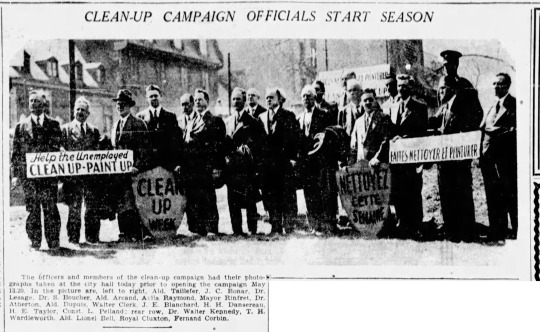
"CLEAN-UP CAMPAIGN OFFICIALS START SEASON," Montreal Star. May 1, 1933. Page 11.
----
The officers and members of the clean-up campaign had their photograph taken at the city hall today prior to opening the campaign May 13.20. In the picture are, left to right, Ald. Taillefer., J. C. Bonar, Dr. Lesage, Dr. S. Boucher, Ald. Arcand, Avila Raymond, Mayor Rinfret, Dr. Atherton, Ald. Dupuis, Walter Clerk, J. E. Blanchard, H. H. Dansereau, H. E. Taylor, Const. L. Pelland: rear row. Dr. Walter Kennedy, T. H. Wardleworth, Ald. Lionel Bell, Royal Cluxton, Fernand Corbin.
#montreal#may day#clean up campaign#clean streets#middle class reformers#middle class ideology#great depression in canada
0 notes
Text
WHY DOES IBS AS A DIAGNOSIS EXIST?
So, if it doesn’t make any sense, why does it still exist and why do a whole bunch of smart people still use it everyday? Well, the simple answer is: we gravitate towards labels to reduce perceived uncertainty and fear. Translation: it feels less scary to be told you have IBS (along with 10% of the population) rather than “we’re not sure what is wrong with you”.
As the man credited with creating the IBS label, Walter C. Alvarez, said in 1947: “The great thing in handling these persons is not to reinforce their fear that there is something seriously wrong with the colon” (4). A label can also allow patients to feel their condition is understandable, that there is research on it and that they are part of a community. It means a person suffering with IBS is not alone or unique, but rather has a condition that others have been able to manage.
IBS has historically been known as a diagnosis of exclusion (3). That is, “we haven’t been able to find a specific cause for your symptoms, sorry”. However, because the unknown element of this diagnosis provided little comfort to many sufferers, attempts have recently been made to make the term a ‘positive diagnosis’. That is, a single condition diagnosed with the Rome IV criteria, rather than the ‘wastebasket’ diagnosis of unknown cause/s. But while a label might make this group of symptoms easier to talk about and provide comfort to sufferers in the short term, it actually does little to empower an individual to find a long-term solution to their symptoms. And I am here to tell you, it is VERY likely that there is a solution.
Sources listed in the article (ones listed in the excerpt are bolded):
Mearin, F., et al. (2016). Clinical Practice Guideline: Irritable bowel syndrome with constipation and functional constipation in the adult. Rev Esp Enferm Dig, 108(6), 332-63
Saha, L. (2014). Irritable bowel syndrome: Pathogenesis, diagnosis, treatment, and evidence-based medicine. World Journal of Gastroenterology, 20(22), 6759–6773
Camilleri, M. (2012). Irritable bowel syndrome: how useful is the term and the “diagnosis”? Therapeutic Advances in Gastroenterology, 5(6), 381–386
Alvarez, W. (1947). Indigestion and abdominal pain with negative findings. Canadian Medical Association Journal, 57(5), 425–432
Canavan, C., West, J., & Card, T. (2014). The epidemiology of irritable bowel syndrome. Clinical Epidemiology, 6, 71–80
Chang, H., et al. (2015). Irritable bowel syndrome and the incidence of colorectal neoplasia: a prospective cohort study with community-based screened population in Taiwan, Br J Cancer, 112(1), 171-6
Distrutti, E., Monaldi, L., Ricci, P., & Fiorucci, S. (2016). Gut microbiota role in irritable bowel syndrome: New therapeutic strategies. World Journal of Gastroenterology, 22(7), 2219–2241
Major, G., & Spiller, R. (2014). Irritable bowel syndrome, inflammatory bowel disease and the microbiome. Current Opinion in Endocrinology, Diabetes, and Obesity, 21(1), 15–21
Spiller, R. (2008). Review article: probiotics and prebiotics in irritable bowel syndrome. Aliment Pharmacol Ther, 28(4), 385-96
Sekar, U., & Shanthi, M. (2013). Blastocystis: Consensus of treatment and controversies. Tropical Parasitology, 3(1), 35–39
Embree, J. (1998). Dientamoeba fragilis: A harmless commensal or a mild pathogen? Paediatrics & Child Health, 3(2), 81–82
Blanchard E., et al. (2008). The role of stress in symptom exacerbation among IBS patients. J Psychosom Res, 64(2), 119-28
Kennedy, P., Cryan, J., Dinan, T., & Clarke, G. (2014). Irritable bowel syndrome: A microbiome-gut-brain axis disorder? World Journal of Gastroenterology, 20(39), 14105–14125
0 notes
Text
Something I Find Fascinating About Nature
I think one of the most amazing things I know about nature is how adaptable it is. A few weeks ago, I had to read the paper “Biodiversity redistribution under climate change: Impacts on ecosystems and human well-being” for BIOL 3130. This paper discussed how as a response to climate change, plant and animal species tend to redistribute across latitudes, deeper into the ocean, and to higher altitudes, and how these shifts affect human populations (Pecl et al., 2017). I think it is amazing how nature can respond to environmental pressures, which helps prevent the entire ecosystem from collapsing when small changes occur. Redistribution also symbolizes a need for humans to make a change in their actions. If species need to keep shifting ranges to survive, eventually species will reach a point where there is nowhere else to go and will go extinct. As well, the fact that shifting range to a more suitable environment is even possible fascinates me. I cannot explain exactly why, but the fact that it is possible amazes me.
While I find this concept fascinating, it is also a double-edged sword and can act as a barrier to governments introducing policies to protect the environment.
As our textbook mentions, climate change is a threat to communities, food production, and safety, and decision-makers need to understand the effects on the environment (Beck et al., 2018). As part of my program, I am doing a minor in criminal justice and public policy and a minor in biology, so I have experience learning about both the science and the policy end of climate change. From my perspective, and from what I have learned, part of the challenge with introducing policies to limit carbon emissions and protect the environment is a lack of solid evidence of the harms of climate change preventing decision-makers from doing anything. The adaptability of nature, as demonstrated through climate-change-driven redistribution is an example of why there is not enough concrete evidence to push decision-makers. Since species shift ranges, they have managed to avoid mass extinctions, at least at this point in time. As such, policymakers may not see a reason to introduce potentially controversial policies.
On a more philosophical level, the adaptability of nature is inspiring. If something like a plant or a tree species can move when things in its natural habitat are no longer suitable, so can I. If I am not happy with where I am in life, I can make a change. It might take time but if I cannot thrive and grow in one place, I can shift myself to a new place, whether that be physically moving or just a mental shift. The strength and adaptability of nature inspire me to make a change if I am unable to thrive where I am.
Before reading the article for BIOL 3130, I had no idea that range shifts were a way for species to respond to climate change. Were you aware of this before? As well, is there any other example of plasticity in nature that you find fascinating?
Sources
Beck, L,. Cable, T.T., & Knudson, D.M. (2018). The bright future of interpretation. Interpreting cultural and natural heritage for a better world (pp. 457-478) Sagamore Publishing.
Pecl, G. T., Araújo, M. B., Bell, J. D., Blanchard, J., Bonebrake, T. C., Chen, I.-C., Clark, T. D., Colwell, R. K., Danielsen, F., Evengård, B., Falconi, L., Ferrier, S., Frusher, S., Garcia, R. A., Griffis, R. B., Hobday, A. J., Janion-Scheepers, C., Jarzyna, M. A., Jennings, S., … Williams, S. E. (2017). Biodiversity redistribution under climate change: Impacts on ecosystems and human well-being. Science (American Association for the Advancement of Science), 355(6332), 1389–1389. https://doi.org/10.1126/science.aai9214
0 notes
Text
Les nouveautés de la semaine (07/11/2022)
À la une : Les grands défis économiques : l'urgence du long terme / Olivier Blanchard et Jean Tirole

Cote de rangement : HC 59 .3 B 265591 / Domaine : Economie
"Cet ouvrage présente et explique les principales conclusions du Rapport Blanchard-Tirole. En 2020, le président Emmanuel Macron proposait en effet aux auteurs de constituer une commission indépendante pour explorer les grands défis à venir. Le travail de cette commission internationale de vingt- quatre économistes aboutit à un rapport portant sur trois défis structurels pour l'économie mondiale : le changement climatique, les inégalités et l'évolution démographique. Ces trois défis sont véritablement existentiels car si nous ne les relevons pas, nous mettons en péril l'avenir de nos sociétés. Et pourtant, les gouvernements ne cessent de repousser l'heure des décisions. La question est donc simple : comment faire adopter des solutions nécessaires mais coûteuses et sans retombées positives immédiates ? Il faut s'efforcer de dépasser la stricte rationalité économique : pour chacun de ces défis, la réponse doit consister en un ensemble de réformes complémentaires, qui prennent en compte les perceptions et, surtout, les multiples dimensions de la question. Il est impératif que nos politiques reflètent enfin l'urgence du long terme." - Quatrième de couverture
------------------------------------
Sociologie
Le travail de l'habitus dans l'œuvre de Pierre Bourdieu / André Mary
Cote de rangement : HM 479 .B68 M 265582
La valeur des personnes : preuves et épreuves de la grandeur / Nathalie Heinich
Cote de rangement : HM 681 H 265584
The origins and dynamics of inequality : sex, politics, and ideology / Jon D. Wisman
Cote de rangement : HM 821 W 265596
La religion woke / Jean-François Braunstein
Cote de rangement : HM 1176 B 265573
Invisible weapons : infiltrating resistance and defeating movements / Marcus Board Jr
Cote de rangement : HN 49 .R33 B 265592
Sans classe ni place : l'improbable histoire d'un garçon venu de nulle part / Norbert Alter
Cote de rangement : HT 612 A 265590
Comment agir face au cyberharcèlement / Bruno Humbeeck
Cote de rangement : HV 6773 .15.C94 H 265578
------------------------------------
Sciences politiques
Géopolitique des États-Unis / Jean-Éric Branaa
Cote de rangement : JC 319 B 265575
Le malheur militant / sous la direction de Olivier Fillieule, Catherine Leclercq et Rémi Lefebvre
Cote de rangement : JC 328 .3 M 265574
Philosophie des relations internationales : anthologie / Frédéric Ramel
Cote de rangement : JZ 1242 R 265581
Revolutionary contagion and international politics / Chad E. Nelson
Cote de rangement : JZ 1315 N 265593
------------------------------------
Sciences du travail
Le droit du travail en sociologue
Cote de rangement : K 1705 D 265576
------------------------------------
Gestion
Adoptez l'esprit proofmaking : dépassez l'incertitude, innovez, et propulsez vos projets / Mathias Béjean, Stéphane Gauthier, Constance Leterrier, Matthieu Cesano
Cote de rangement : HD 45 B 265577
Le commun comme mode de production / Francesco Brancaccio, Alfonso Giuliani, Carlo Vercellone
Cote de rangement : HD 1286 B 265580
À bout de flux / Fanny Lopez
Cote de rangement : HF 5548 .2 L 265588
------------------------------------
Économie
Essays on liberalism and the economy / F. A. Hayek
Cote de rangement : HB 171 H 265595
Commerce, argent, pouvoir : l'impossible avènement d’un capitalisme en Chine, XVIe-XIXe Siècle / François Gipouloux
Cote de rangement : HC 427 C 265587
------------------------------------
Histoire
Un empire de velours : l'impérialisme informel français au XIXe siècle / David Todd
Cote de rangement : DC 252 T 265586
------------------------------------
Santé
Sortir des crises : One Health en pratiques / sous la direction de Sébastien Gardon, Amandine Gautier, Gwenola Le Naour et Serge Morand
Cote de rangement : RA 643 S 265579
Servitudes virtuelles / Jean-Gabriel Ganascia
Cote de rangement : RC 569 .5.I54 G 265589
------------------------------------
Psychologie
Nostalgie : histoire d'une émotion mortelle / Thomas Dodman
Cote de rangement : BF 575 .N6 D 265585
Le juste équilibre : entre plaisir et souffrance / Paul Bloom
Cote de rangement : BF 789 .S8 B 265583
------------------------------------
Communication
Politicians' reading of public opinion and its biases / Stefaan Walgrave, Karolin Soontjens, Julie Sevenans
Cote de rangement : HM 1236 W 265594
----------------------------------------------------------------------------------------------
Tous ces ouvrages sont exposés sur le présentoir des nouveautés de la BSPO. Ceux-ci pourront être empruntés à domicile à partir du 21 novembre 2022.
#Economie#Sociologie#SciencesPolitiques#SciencesDuTravail#Gesion#Histoire#Sante#Psychologie#Communication
0 notes
Text
Twenty-Eight Of The Gang
Some obnoxious surnames and more #Victorian #slang
Our language has lost some marvellous words along the way. Mawwormy was an adjective used to describe someone being picky or the act of fault finding. It owed its origin to a character in Isaac Bickerstaffe’s play of 1769, The Hypocrite. Perhaps being mawwormy is to call a dog that is reluctant to fight a meater, one that only bites into meat.
Advertising has long made its mark in popular…

View On WordPress
#E L Blanchard#his elm is grown#James Ware#mawwormy#meater#mustard plaster#Norfolk Howard#obnoxious surnames#Passing English of a Victorian Era
0 notes
Text
Anna Cora Mowatt and Pauline at the Marylebone
Anna Cora Mowatt and Pauline at the Marylebone
Part XIII: Love
Like Christmas, Easter in mid-19th century England was a prime theatre-going holiday. Playhouses scheduled lavish extravaganzas to tempt patrons and out-of-town visitors. “The Lady of Lyons” was staged at the Marylebone Theatre in London on number of dates before and after the Easter Holidays in the spring of 1849 as part of a calendar packed with special events, including the…

View On WordPress
#anna cora mowatt#Armand#Astor Place Riots#Charlotte Cushman#E. L. Blanchard#E. L. Davenport#Edward Bulwer-Lytton#Edwin Forrest#Fanny Vining#John Oxenford#Lady of Lyons#melodrama#Sadler&039;s Wells Theater#Samuel Phelps#The Lady Actress#theater history#theatre history#theatrical autobiography#Victorian Actress#Victorian theater#victorian theatre#Walter Watts#Watts Scandal#William Macready
1 note
·
View note
Text
“A strange case of Mr Foster”
Do you still remember the "Hunter Foster is 20 years old" meme? The one where we couldn’t believe he was almost fourty in Frankenstein?
Yesterday my dearest friend @the-gay-sailor pointed it out once again:

She was right! After a quick Google search I noticed a strange pattern:
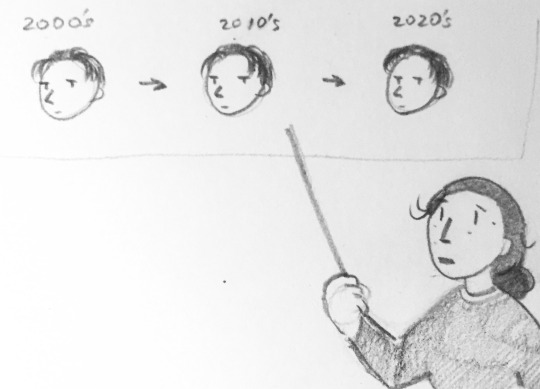
It seems as if Mr Foster had the exact same face with little to none signs of aging. He has looked the same in early Broadway roles as he looks now, in a few months old interviews.
Which had led me to an intriguing conclusion:
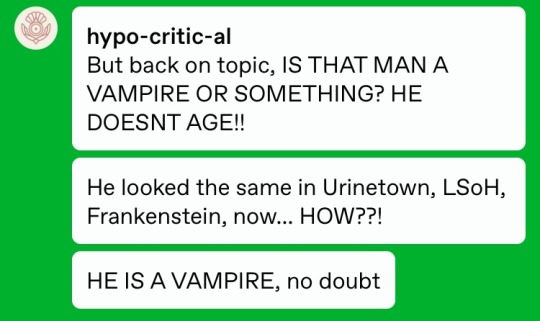
This seems as an only reasonable explanation.
Mr Foster’s doesn’t age.
He is a VAMPIRE.

So I decided to quickly sketch him as one. He is wearing Frankenstein costume (costumes in that musical were ugly and I can give you an essay on why I think that if you wanted) and a cape, because he can and will wear one.


Another possibility is that instead of feeding on human’s blood at night he goes by his fans’ windows to read them Frankenstein as a bedtime story in his e x c e e d i n g l y p e r f e c t voice.
But there is a problem. If he is a vampire, what would his Frankenstein co-stars think of this? Are they monsters themselves?!

My sweetest friend is right once again and I stand by her theory.
Mr Blanchard is secretly C'thulu.

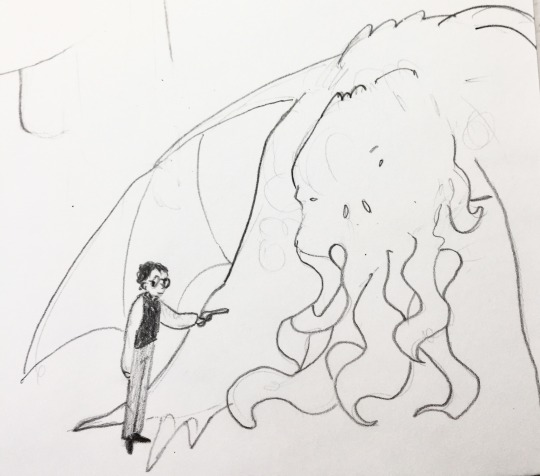

(Please, this post is meant to be a joke and is not intended to be taken seriously. Sailor wrote more and funnier theories surrounding this idea but Tumblr couldn’t let me post more screenshots, what is lame, because she is genuinly funny person.
If you are Mr Foster or Mr Blanchard, we are truly sorry for what you have just witnessed. But if you two are reading then please, make a Frankenstein audiobook, we would appreciate that :).
Thank you everyone for your attention.)
#frankenstein#frankenstein a new musical#hunter foster#steve blanchard#frankenstein musical#we are very sorry to everyone#this is just a joke#go give sailor an attention because she is awesome person#she is the best!#she wrote vampire!foster POV fanfic for your information#and it was hillarious#a message for her: Cthulu Steve singing#i hope you won’t kill me sailor#i don’t know what am i doing at this point#sirs pls don’t sue me or something#for legal reasons this is a joke#this whole post is a one big joke#even outside legal reasons#this post:#/j
53 notes
·
View notes
Text
My Crew for a Movie Adaptation of King Lear
Director: Kasi Lemmons
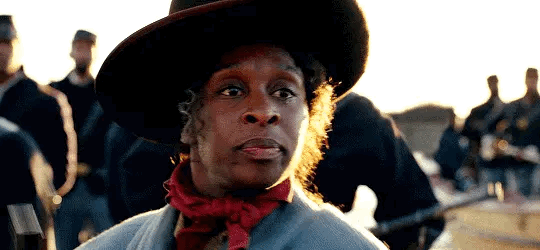
Composer: Terence Blanchard

Cinematographer: John Toll

Screenplay Writer: Eric Roth
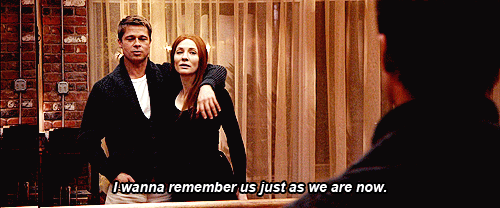
Costume Designer: Ruth E. Carter
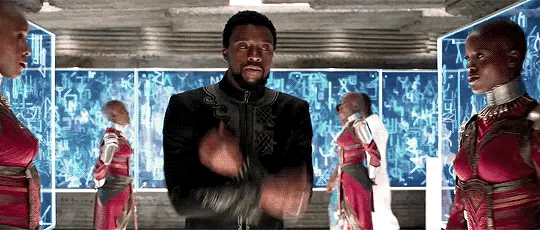
Production Designer: Gemma Jackson

Bonus: Samuel L. Jackson as Lear

#Fancast#King Lear#Kasi Lemmons#Harriet#The Caveman’s Valentine#John Toll#Jupiter Ascending#Braveheart#Gemma Jackson#king arthur: legend of the sword#Aladdin#Ruth E. Carter#Black Panther#Oldboy#Eric Roth#the curious case of benjamin button#Forrest Gump#Terence Blanchard#Blackkklansman#Malcolm X#samuel l. jackson
32 notes
·
View notes
Photo









rowan blanchard by gia coppola for nylon
Blanchard has also been seeking the advice of actresses older than she, Fishel and Room star Brie Larson among them, specifically when the current political mood really gets to her. “These women are the ones who are protecting me,” she says, preparing to head to a friend’s house. They might see it differently—that Blanchard is doing just fine on her own. Fishel even looks up to her younger peer. “I just keep reminding Rowan that everything she has inside of her, she can put out to the world,” she says. “And that’s going to change the world.”
98 notes
·
View notes
Text
Mary Bell
The Tyneside Strangler
TW: child death, sexual abuse, genital mutilation
•
•
•
•
•
Hello! So I’m back with another horrible story because people keep asking for them.
SO HERE WE GO
This is the story of Mary Bell, who is one of only a handful of the youngest murderers.. EVER.
Mary Bell was born to a 16 year old prostitute named Betty in Newcastle upon Tyne, England in May of 1957. (Yeah, this didn’t happen that long ago. Horrifying.)
Now, no one is entirely sure who Mary’s father is, but Betty made it very clear she wanted nothing to do with Mary from the very beginning, telling doctors, “Get that thing away from me.”
And the best thing the doctors could come up with was to continue to let Mary live with her mother.
Perfect. What could go wrong?
Well, a lot.
Things got way worse. Betty was away a lot in Glasgow for her “business trips”. When she wasn’t away, she subjected Mary to physical and mental abuse.
Betty’s sister testified that she once saw Betty try to give Mary away to a local woman who was unsuccessful in her adoption journey.
Betty’s sister also noted that Mary was very “accident prone”; i.e. “falling” down the stairs and “accidentally” overdosing sleeping pills.
After Mary’s “fall”, it was reported that Mary suffered horrible brain damage in her pre-frontal cortex, the part of the brain that deals with decision-making and voluntary movements.
(Richard Ramirez, John Wayne Gacy, Fred West, David Berkowitz, Ed Gein, Albert Fish, and several other serial killers also suffered brain injuries as they were growing up.)
(I want to mention here there is a bit of a debate amongst experts whether to Betty wanted to get rid of Mary because she wasn’t fit to be a mother OR Betty had Munchausen by Proxy, which should all know is my favorite mental illness. 😬
Munchausen Syndrome by Proxy (MSBP) is a mental health problem in which a caregiver makes up or causes an illness or injury in a person under his or her care, such as a child, an elderly adult, or a person who has a disability. The most famous case was Clauddinea “Dee Dee” Blancharde abusing her daughter Gypsy Rose Blancharde.)
Back to Mary.
According to family members, Betty began prostituting Mary out by the time she was four years old. (That’s hideous. That’s a year younger than Shiloh, my baby baby. I hope it isn’t true.)
I also read that by the time Mary was five, she had already had a brush with death, watching her five year old friend being run over and killed by a bus.
By the time Mary was ten, she was quiet, manipulative, and isolated herself from everyone.
In May 11, 1968, just weeks before her first murder, Mary was playing with a three year old neighbor when he was horribly injured from a fall at the top of an air raid shelter.
His parents deemed it an accident.
After this, though, a few of the neighborhood mothers came forward to the police and said Mary had tried to choke their young daughters. No charges were filed, however.
On May 25, 1968, one day before Mary Bell turned 11 years old, Mary strangled four year old Martin Brown in an abandoned house. Mary fled the scene and returned back to the body with her friend Norma Bell, (no relation), but found they had been beaten by two local boys who had been playing in the abandoned house and stumbled upon the body.
Police were baffled by what they saw. Besides a little blood and saliva on Martin’s face, there were no obvious signs of violence. There was, however, an empty bottle of painkillers on the floor near the body. This led police to believe Martin had swallowed the pain pills and his death was deemed an accident.
Mary might have gotten away with this had she not gone to Martin’s family’s house and asked his mother to see Martin. She explained to Mary that Martin was dead, and Mary said she knew, she wanted to see the dead body in the coffin.
Martin’s mother slammed the door in her face.
Shortly after, Mary and her friend Norma broke into a nursery school and vandalized it with notes taking responsibility for Martin Brown’s death and promising to kill again. Police assumed the notes were a morbid prank.
The nursery school installed an alarm system shortly after and Mary and Norma were caught at the scene of the crime but were later seen as loitering and let off the hook.
Just.. YA KNOW!? All the signs are pointing to this girl.
Mary even told her classmates she had murdered Martin Brown.
It’s aggravating as hell.
BUT I DIGRESS
On June 31, 1968, Mary Bell, now 11, strangled three year old Brian Howe to death in the same area where she strangled Martin Brown.
She later went back to the body and carved an ‘M’ onto Brian’s chest with a razor and mutilated his thighs and penis with a pair of scissors.
In a sickening twist, Mary and Norma offered to help Brian’s sister look for him when his family realized he was missing. Mary even pointed out the cinder blocks where his body was, but since Norma said it wouldn’t be there, Brian’s sister dismissed it and looked elsewhere.
Y’all. I cannot.
When the coroner’s report came back on Brian, police were shocked to find the ‘M’ carved onto his chest and the coroner reporting this death was most likely caused by a child due to the lack of force used during the attack.
MORTIFYING
Mary and Norma were not conspicuous at all; they were interviewed by the police and excited to learn new news pertaining to the case.
Mary was spotted lurking outside of Brian’s house the day of his burial. She was laughing and rubbing her hands together when she saw the coffin.
The police called Mary in to be interviewed a second time and Mary made up a story about an eight year old boy she had seen hit Brian, (police knew she and Norma had seen him the day he died), in the head and that he had a pair of broken scissors with him.
The 👏🏼 police 👏🏼 hadn’t 👏🏼 disclosed 👏🏼 anything 👏🏼 publicly 👏🏼 about 👏🏼 the 👏🏼 scissors. 👏🏼
This is where Mary done goofed. Only investigators and the murderer would have known about this clue.
Upon further questioning, Mary and Norma broke down and began blaming each other for the murders.
During the trial, which took place in December, the jury agreed that Mary had committed the murders.
Did she receive a murder charge, you may ask?
Absolutely not.
While the jury did find Mary Bell guilty, a manslaughter charge was given because Mary’s lawyer and the court psychiatrists argued Mary suffered from psychopathy, and the court agreed she was not fully responsible of her actions.
😐😐😐😐😐😐😐😐😐😐😐😐
Norma Bell, however, was regarded as an unwilling accomplice and was acquitted.
Let’s look at the difference between manslaughter and murder charges and why this is so important.
man·slaugh·ter
/ˈmanˌslôdər/
noun
1. the crime of killing a human being without malice aforethought, or otherwise in circumstances not amounting to murder.
mur·der
/ˈmərdər/
noun
1. the unlawful premeditated killing of one human being by another.
I obviously haven’t gone to law school, but I would argue that the little neighbor boy’s “accidental fall” and the mothers coming forward about Mary choking their young daughters could be viewed as premeditated. She was trying to kill them, she just managed to kill two little boys instead.
Yes she had a brain injury, but giving her a manslaughter charge is offensive to me. Offensive for the families who lost their sons. If she has a brain injury and there were several cases documented where she was hurting other children, she should have been locked away forever. Just my opinion. I agree with medication and therapy, but anyone could relapse at any time and I don’t think that’s a risk anyone should take. Again, just my unprofessional as h*ck opinion.
(Ed Kemper went to a mental institute and tricked and lied his way into letting the psychiatrists let him leave after he had killed both of his grandparents at just 15 years old. They assumed he was rehabilitated; he just learned the right answers to their questions. He later killed eight more people, including his mother.
Just an example.)
(Another example, they medicated Richard Kuklinski after he was arrested and did not feel the need to release him even though he showed signs of improvement.)
Moving on.
The judge concluded that Mary was a dangerous person and a serious threat to other children. She was sentenced to be imprisoned “at Her Majesty’s pleasure,” a British term that basically means the powers that be would release her when they felt she had been properly rehabilitated.
Apparently, they were very impressed with Mary’s treatment and rehabilitation and felt like it was appropriate to let Mary Bell out in 1980, T W E L V E Y E A R S after Mary committed these murders.
She was put in very strict probation but was able to live amongst her community as a normal person.
The cherry on top?
Mary Bell was given a new identity to offer her a new chance at life and to be able to avoid the press.
She had to move several times because the press kept tracking her down, however.
Today, Mary Bell and her daughter are in protective custody at a secret address no one knows.
Norma Bell passed away in 1989.
Do I feel Mary Bell needs court ordered protection and should be able to hide her identity? No.
Do I think they released her far too early? Yes
Do I think Martin Brown and Brian Howe got justice? No.
Does this story anger me even though I’ve heard it and read about it fifteen million times? Yes.
Her mother should be responsible. She should be responsible instead of hiding. The victim’s families deserve better.
Below are pictures of Mary Bell aged 11, Martin Brown, Brian Howe, and Mary Bell aged 51.



4 notes
·
View notes